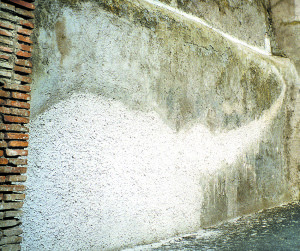I Nuovi Mostri
Walls1995 – “Incantesimi”, scene d’arte e poesia a Bomarzo
cm 175 x 180 x 380
di Miriam Mirolla
In climbing up towards the old part of Bomarzo, brushing past the wall roots of Palazzo Orsini, for a moment you can throw your distracted glance on the smooth and plastered wall. It is the basis of a princely palace, the architecture desired by the doleful and hunchbacked Vicino Orsini.
Then the curve flanks you with the climbing building, and the natural landscape with the richly green valley of the Bosco Sacro [Holy Wood] returns to catalyze the entire attention of the traveller. And yet… a light and darker “shade” on the plaster is still visible and with the corner of one’s eye one is aware as if it were a “double” imaginary and nocturne of the solar world of Bomarzo. Today that shade still lightens near the curve, continuing to tell its story…
It was the Summer of 1995 when an eccentric and solitary artist with a blazing tie lying beneath a vaguely melancholy face of a noble clown explored the streets of Bomarzo with a vigilant eye. As happens with love at first sight, for his installation he rapidly chose an abandoned place, a hole in the rock, perhaps an air vent of the massive Palace which had already ‘breathed’ for almost five centuries.
And with the sacralization of the person about to found a city Fiorenzo Zaffina began to excavate in the peperino stone, as the psychoanalyst delves into the unconscious of a human being, slowly and methodically, until with the patience of a detective he recomposed a scene – the primary scene? – to give an integral sense, to narrate a story one can read easily from whatever point one wants.
Moreover, in Zaffina’s case (as in the metaphorical gesture of any archaeologist) the excavation, the digging alludes and always refers to an original interment, to an ‘ancient’ death , an immobilized truth which in any case wishes to see the light of day: a taboo, in short.
And so a posteriori the events have revealed all of the internal coherence of this ‘work-taboo': in fact, the installation after having won the prize of the popular jury – in competition with other forty works – was transformed into the subject of a contention, giving rise to an interminable wake of discussions regarding the relationship between contemporary art and ancient-cum-old history, between conservation and the restoration of ephemeral works and concerning the merits and defects of the so-called “environmental installation”. Although even before the dialogue between the parts began, and not to mention a lengthy legal battle, the work had already been destroyed, removed and buried. Now that legal battle has been concluded in favour of the artist. However, in the haste ‘to check’ the broken taboo even the structural function of that simple “hole of air” was ignored. A ‘curtain was drawn’ of lime and cement over the scene. With all haste possible the tomb was closed up again and regarding that event nothing remains in Bomarzo except that “shade”.
by Miriam Mirolla
LA STORIA
Nel 1995 Fiorenzo Zaffina fu invitato da Simonetta Lux e Miriam Mirolla al primo festival Incantesimi, scene d’arte e poesia a Bomarzo. Alla manifestazione, consistente in interventi nel centro storico, parteciparono 50 artisti. Zaffina, autorizzato dagli organizzatori e dal Comune, utilizzò per il suo “intervento” una grotta, deposito ormai di materiali di scarico e immondizia, che si trovava alla base di un muro su strada. L’opera donò al luogo una nuova vita. Il pubblico, attraverso un reticolo di pietre, scrutava l’interno cavernoso dove erano stati riposti una serie di computer ancora funzionanti, monitor e tastiere. Da un lato del “buco” il disegno, fatto d’intonaco scrostato, tracciava una coda che giustificava anche il titolo dell’opera, I nuovi mostri. A Fiorenzo fu assegnato l’orso d’argento, unico premio in palio. La giuria era composta dai visitatori della mostra e dai cittadini di Bomarzo. Chiunque poteva votare liberamente l’opera che più gradiva.
Nel 1996, in occasione della seconda edizione del festival, a Fiorenzo fu chiesto di restaurare l’opera con la collaborazione di osservatori laureandi in storia dell’arte contemporanea della Facoltà di Conservazione dei Beni Culturali.
L’opera fu donata alla città. Il 13 agosto 1997 fu distrutta e murata dall’ordinanza del sindaco Tiziana Lagrimino, senza che l’artista fosse messo al corrente di quanto stesse accadendo. La ragione di tale atto fu l’esposto di un cittadino di Bomarzo, il quale denunciava che l’opera era stata realizzata su un immobile di proprietà comunale, stabile vincolato dalla legge 1089/39. Il Comune di Bomarzo e il Museo Laboratorio, con la Provincia di Viterbo e la Pro loco, erano i patrocinatori della mostra. La notizia fu ripresa dai giornali e non mancarono le proteste dei cittadini e dell’opposizione nel Consiglio Comunale di Bomarzo. Sembrava ormai che la vicenda non avesse altro sbocco, quando il 12 febbraio 1998 Fiorenzo Zaffina ricevette un avviso di garanzia dalla Procura della Repubblica di Viterbo. Il 9 aprile 1998 fu rinviato a giudizio assieme ad Antonio Cianchi, ex sindaco del Comune di Bomarzo, in carica all’epoca della mostra.
Il caso fu oggetto di discussione in un convegno tenuto a Roma presso il Museo Laboratorio di Arte contemporanea dell’Università “La Sapienza”il 4/11/98. Al convegno, introdotto da Maurizio Calvesi intervennero Simonetta Lux, Miriam Mirolla, Pio Baldi, Fabrizio Lemme, Rosario Tarantola, Giorgio Muratore, Alessandra Mammì, Fabio Sargentini, Tonino Sicoli, Roberto Cotroneo, Renato Barilli, Nicola Carrino, Stefano Colonna. In quella occasione l’artista realizzò un’opera su un muro del museo dal titolo “Libera arte in libero Stato”.
La data del processo fu fissata per il giorno 11/11/1998 presso il Pretore di Viterbo nella Sezione Distaccata di Civita Castellana.
Dopo una serie di rinvii, il giorno 8/11/1999 l’artista (difeso dall’avvocato Tarantola) fu assolto perché il fatto non costituisce reato e perché il fatto non sussiste.

